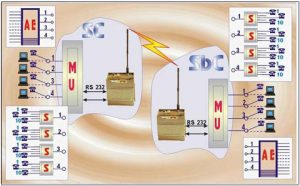It is intended for creation of multi channel radiotelephone communication:
a) for subscribers of out-of-the-way and remote regions, where there are not enough telephone lines;
b) between automatic exchanges (AE);
c) between subscribers of commutators (C).
It is used for creation of special types of communication and for development of operative channels at extreme circumstances.
Wireless extender provides high noise-immunity and reliability of transmitting information, by using of spread-spectrum systems of communication and digital processing of data with additional coding of information.
On the long distances it can be used as repeater with using of additional extender. Using method of the digital transmission and signals’ processing removes the limitation of retransmissions coefficient.
Wireless extender consists of station complete (SC) and subscriber complete (SbC). Main units of SC and SbC are radio modem (RM) and matching unit (MU).
Diagram of radiotelephone communication based on wireless extender

